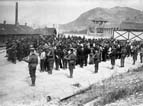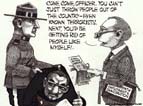Internment Past and Present
Perhaps one of the factors which contributed to the absence of sabotage, or evidence of “5th column” activities, so far, is due to the fact that promptly upon the outbreak of war all known Nazi agents were immediately arrested by this force and placed in internment camps.
RCMP Annual Report, 1940
It was just a travesty. It was just a travesty. Certainly it wasn’t as bad as what they did to the Japanese, but that’s not the point, you know.
Rita Morreale, video interview, Columbus Centre Collection
• During World War I, more than 8500 people – originating from the Austro-Hungarian, German, and Ottoman Empires as well as the Kingdom of Bulgaria – were interned in Canada.
• Italian Canadians were not the only ethnic group interned during World War II. The Canadian government ordered the internment of roughly 800 German Canadians and 700 Japanese Canadians. And more than 22,000 Japanese Canadians were forcibly relocated. Members of both the Communist Party of Canada and the Fascist National Unity Party were interned during the war.
• In the 1950s, the Canadian government compiled lists of 16,000 suspected communists and about 50,000 communist sympathizers. Known as PROFUNC (Prominent Functionaries of the Communist Party), the individuals on these lists would be arrested and interned in the event of a war between Canada and the Soviet Union or China.
• The War Measures Act was again introduced in 1970 during the October Crisis, when a British Trade Commissioner and Quebec’s Minister of Labour were kidnapped by members of the Front de Libération du Quebec (FLQ). About 500 people were arrested and detained for as long as three weeks. Only 62 of those arrested were charged.
• Parallels exist between what Italians in Canada experienced during World War II and what Arab and Muslim Canadian communities experienced following the September 11, 2001, attacks on the World Trade Center in New York. In both cases, an environment of fear and xenophobia resulted in arrests, vandalism and violence. Court proceedings resulted in prison sentences for a few Arab and Muslim Canadians for terrorist-related offences. Others incarcerated under a security certificate have not seen the evidence against them nor been tried in a court of law. As a result, these communities have been stigmatized as enemies of the Canadian state even though the vast majority of individuals are law-abiding citizens.
• In June 2010, during Toronto’s G20 Summit, more than 1100 people were interned for the weekend as a result of Regulation 233/10, which was created under the existing Public Works Protection Act. This regulation designated the city’s downtown as a public work thereby giving police the authority to request identification and search an individual without a warrant, if they tried to enter the area, or risk arrest. However, the way in which this regulation was enforced resulted in the largest mass arrest in Canadian history. The majority of those arrested were released without being charged.



